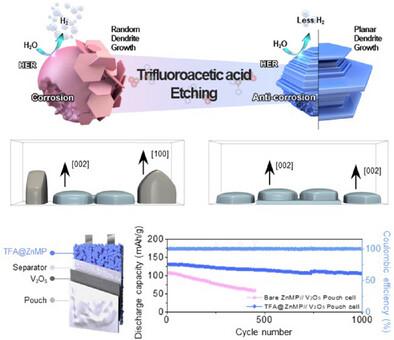Trifluoracetic Acid‐Driven (002) Facet Engineering of Zn Metal Powder Anodes for High‐Performance Aqueous Zinc‐Ion Batteries
IF 26
1区 材料科学
Q1 CHEMISTRY, PHYSICAL
引用次数: 0
Abstract
Zinc metal powder (ZnMP) anodes present significant advantages over conventional zinc foil anodes in aqueous zinc‐ion batteries (AZIBs), offering higher electrochemically active surface area and improved mass utilization. However, the 3D morphology of ZnMP particles poses challenges for crystallographic control, as their random orientations and large surface areas intensify hydrogen evolution reactions (HER), corrosion, and dendritic growth. Here, a dual‐functional etching strategy using trifluoroacetic acid (TFA) is reported to selectively modify ZnMP surfaces and enrich thermodynamically stable (002) crystal planes. Upon dissociation, TFA releases H

三氟乙酸驱动(002)用于高性能水性锌离子电池的锌金属粉末阳极的Facet工程
锌金属粉末(ZnMP)阳极在水性锌离子电池(AZIBs)中比传统的锌箔阳极具有显著的优势,具有更高的电化学活性表面积和更好的质量利用率。然而,ZnMP颗粒的三维形貌给晶体学控制带来了挑战,因为它们的随机取向和大表面积加剧了析氢反应(HER)、腐蚀和枝晶生长。本文报道了一种使用三氟乙酸(TFA)的双功能蚀刻策略,可以选择性地修饰ZnMP表面并丰富热力学稳定的(002)晶体平面。在解离时,TFA释放出H+离子,优先蚀刻高能面,而CF3COO−阴离子选择性地吸附在(002)平面上,形成保护层,稳定蚀刻过程。这种处理产生了独特的阶梯式六边形形态,在(002)平面上富集,减轻了寄生反应,促进了均匀的锌沉积。TFA修饰的ZnMP (TFA@ZnMP)电极表现出卓越的稳定性,在对称电池中工作超过1000小时。在与V2O5阴极配对的实际4 × 3 cm2袋电池中,电极在10 A g−1下循环1000次后保持79.8%的容量。密度泛函理论计算和相场建模证实了离子优先吸附机理及其对电化学性能的提高。这些发现表明,这种表面工程策略是一种可扩展的高性能azib途径。
本文章由计算机程序翻译,如有差异,请以英文原文为准。
求助全文
约1分钟内获得全文
求助全文
来源期刊

Advanced Energy Materials
CHEMISTRY, PHYSICAL-ENERGY & FUELS
CiteScore
41.90
自引率
4.00%
发文量
889
审稿时长
1.4 months
期刊介绍:
Established in 2011, Advanced Energy Materials is an international, interdisciplinary, English-language journal that focuses on materials used in energy harvesting, conversion, and storage. It is regarded as a top-quality journal alongside Advanced Materials, Advanced Functional Materials, and Small.
With a 2022 Impact Factor of 27.8, Advanced Energy Materials is considered a prime source for the best energy-related research. The journal covers a wide range of topics in energy-related research, including organic and inorganic photovoltaics, batteries and supercapacitors, fuel cells, hydrogen generation and storage, thermoelectrics, water splitting and photocatalysis, solar fuels and thermosolar power, magnetocalorics, and piezoelectronics.
The readership of Advanced Energy Materials includes materials scientists, chemists, physicists, and engineers in both academia and industry. The journal is indexed in various databases and collections, such as Advanced Technologies & Aerospace Database, FIZ Karlsruhe, INSPEC (IET), Science Citation Index Expanded, Technology Collection, and Web of Science, among others.
 求助内容:
求助内容: 应助结果提醒方式:
应助结果提醒方式:


